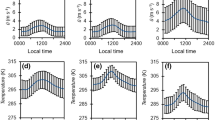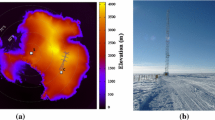Abstract
The term ‘variangular’ is introduced to emphasize a significant difference between the present and certain earlier solutions to the problem of organized airmotion within the planetary boundary layer. The latter belong to the family of equiangular wind spirals and have the characteristic that the angle (ψ) formed by the vectors of shearing stress and geostrophic departure is invariant with height; it is shown that in this spiral-family, parabolic height-dependency of the effective (eddy) diffusivity (K) alone is permitted, including the asymptotic case of constant K; the famous Ekman spiral as well as the Rossby spiral are two prominent members of the family of equiangular wind spirals. The new variangular theory, as the name implies, permits variation of ψ with height (z) and produces more versatile profiles of wind and stress due to less restraint in K (z). As an example of comparison with observed data, monthly mean wind profiles obtained at Plateau Station, Antarctica, are selected since they exhibit a noteworthy degree of ‘variangularity’, in relatively satisfactory agreement with properties of the new theoretical model for wind spirals.
Similar content being viewed by others
References
Blackadar, A. K.: 1962, ‘The Vertical Distribution of Wind and Turbulent Exchange in a Neutral Atmosphere’, J. Geophys. Res. 67, 3095–3103.
Dabberdt, W. F.: 1970, ‘A Selective Climatology of Plateau Station, Antarctica’, Submitted for publication as a ‘Note’ in the J. Appl. Met.
Dalrymple, P. C.: 1969, ‘Micromet Programs in East Antarctica and Thailand’, Bull. Am. Meteorol. Soc. 50, 2, 80–81.
Ekman, E. V.: 1902, Myt. Mag. Naturv., 40.
Koehler, H.: 1932, ‘Ein kurzes Studium des Austausches auf Grund des Potenzgesetzes’, Beitr. Phys. Atmos. 19, 91–101.
Lettau, B.: 1967, ‘Thermally and Frictionally Produced Wind Shear in the Planetary Boundary Layer at Little America, Antarctica’, Monthly Weather Rev. 95, 9, 627–634.
Lettau, H.: 1954, ‘Improved Models of Thermal Diffusion in the Soil’, Trans. Am. Geophys. Un. 35, 121–132.
Lettau, H.: 1962a, ‘Theoretical Wind Spirals in the Boundary Layer of a Barotropic Atmosphere’, Beitr. Phys. Atmos. 35, 195–212.
Lettau, H.: 1962b, ‘Equiangular Wind and Current Spirals’. Final Report, Contract DA-36–039-SC-80282, Dept. Met. Univ. Wis., Madison, pp. 159–72.
Lettau, H.: 1962c, ‘A Theoretical Model of Thermal Diffusion in a Non-Homogeneous Conductor’, Gerlands Beitr. Geophys. 71, 257–71.
Prandtl, L. and Tollmien, W.: 1925 ‘Die Windverteilung über dem Erdboden errechnet aus den Gesetzen der Rohrströmung’, Z. Geophysik 1, 47–55.
Rossby, C. G.: 1932, ‘A Generalization of the Theory of the Mixing Length with Applications to Atmospheric and Oceanic Turbulence’, Mass. Inst. Tech. Papers, Vol. 1, No. 4.
Author information
Authors and Affiliations
Additional information
National Research Council Visiting Scientist Research Associate, Regional Environments Division, Earth Sciences Laboratory.
Rights and permissions
About this article
Cite this article
Lettau, H.H., Dabberdt, W.F. Variangular wind spirals. Boundary-Layer Meteorol 1, 64–79 (1970). https://doi.org/10.1007/BF00193905
Received:
Issue Date:
DOI: https://doi.org/10.1007/BF00193905




